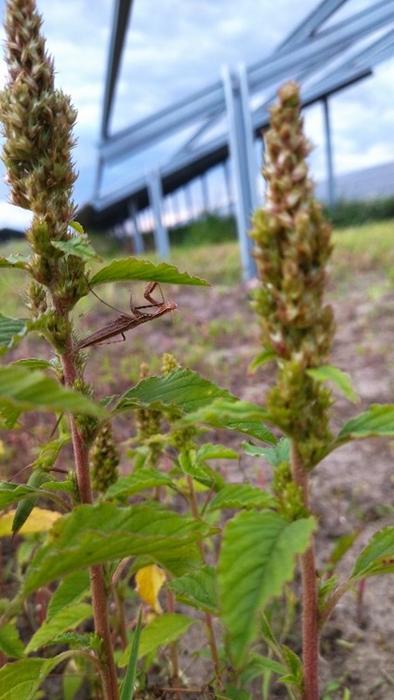Large-scale ground-mounted solar parks have emerged as a significant element in the global transition toward renewable energy, yet their potential for supporting biodiversity has often been overshadowed by perceptions of vast, lifeless landscapes. Recent research by Dr. Markus Zaplata, a dedicated scientist at Anhalt University of Applied Sciences in Germany, sheds new light on this subject. His findings indicate that these solar installations can not only coexist with various forms of life but may also actively foster them. Central to his work is the interaction between solar park maintenance and vegetation succession, a natural process that influences plant communities over time.
Dr. Zaplata’s research delves into how solar parks can provide ecological benefits, serving as habitats for different species, including plants, insects, and birds. Historically, these installations have been viewed merely as energy-generating spaces, devoid of ecological value. However, by studying plants such as Mantis religiosa, commonly known as the European Mantis, he illustrates the intricate relationship between solar infrastructure and local biodiversity. His work challenges the preconceived idea that solar parks are detrimental to natural habitats, highlighting instead their potential as multifunctional spaces that can support wildlife.
The concept of vegetation succession, which denotes the gradual process through which ecosystems evolve and diversify, plays a critical role in Dr. Zaplata’s arguments. He asserts that solar parks are not static environments; rather, they undergo significant ecological changes over time. Early stages of succession often feature easily dispersed species such as grasses and herbs. However, if managed properly, these areas can evolve to support more complex plant communities, including woody species. This transformation underscores the importance of adaptive landscape management strategies aimed at enhancing biodiversity within solar parks.
Despite the potential benefits, Dr. Zaplata emphasizes potential challenges that arise in the management of these ecosystems. One significant concern is the encroachment of self-seeded woody plants, which can become competitive and invasive if left unchecked. His research indicates that conventional maintenance measures, such as regular mowing, are often inadequate. While mowing can provide temporary relief, it does not address the underlying biological processes that enable vegetation to thrive. As he points out, subsurface woody structures can persist post-mowing, eventually leading to complications for solar energy systems, including shading of solar panels and interference with operational efficiencies.
With nearly two decades of experience studying vegetation dynamics and interaction with human infrastructure, Dr. Zaplata’s insights are particularly timely. The rapid expansion of solar energy installations necessitates a re-evaluation of current practices to incorporate ecological considerations. He believes effective management strategies should include an understanding of the interactions between vegetation succession and solar technology, paving the way for sustainable energy landscapes that benefit both energy producers and biodiversity.
The biological interplay within solar parks can extend their benefits beyond mere energy generation. By retaining and promoting native vegetation, solar installations can serve as valuable habitats for a variety of species. This approach aligns with a broader commitment to sustainable land use and can intersect with agricultural practices, ultimately fostering a renewed connection between energy production and food systems. Dr. Zaplata envisions a future where solar park managers, environmentalists, and agricultural stakeholders collaborate, designing landscapes that are beneficial for both energy generation and biodiversity.
As the energy sector evolves, so too must our management practices. Tapping into the knowledge of ecologists and landscape biologists is integral to this process. Dr. Zaplata advocates for consulting with experts who possess a nuanced understanding of dynamic vegetation processes. This collaboration could inform the design and maintenance of solar parks, ensuring that ecological integrity is preserved while maximizing energy yields. The balance between energy production and ecological health is a delicate one and one that requires careful consideration to navigate successfully.
In conclusion, Dr. Markus Zaplata’s research serves as a clarion call for the renewable energy sector. It challenges long-held assumptions about the ecological impact of solar parks and lays a foundation for future sustainability efforts. The enduring lessons of vegetation succession, combined with innovative management strategies, can redefine how we approach the intersection of energy production and environmental stewardship. By prioritizing biodiversity in solar park design and maintenance, we can harness the potential of these landscapes to not just produce energy, but to nurture life within them.
As the world grapples with the urgent need to shift to renewable energy sources, Dr. Zaplata’s findings underscore an essential truth: renewable energy and biodiversity are not mutually exclusive. Instead, with thoughtful management, they can coexist, creating landscapes that are vibrant, productive, and capable of supporting both human and ecological communities thriving together.
Subject of Research: Biodiversity in solar parks
Article Title: Management and sustainability of ground-mounted solar parks requires consideration of vegetation succession as an omnipresent process
News Publication Date: 10-Feb-2025
Web References: DOI Link
References: Zaplata M (2025) Management and sustainability of ground-mounted solar parks requires consideration of vegetation succession as an omnipresent process. One Ecosystem 10: e141583.
Image Credits: Credit: Dr Markus Zaplata
Keywords: Solar parks, biodiversity, vegetation succession, renewable energy, landscape management, ecological sustainability, Dr. Markus Zaplata.
Tags: coexistence of solar parks and natureDr. Markus Zaplata researchecological benefits of solar installationsecological value of solar energy sitesEuropean Mantis habitat in solar parksmultifunctional solar park designplanning for biodiversity in solar infrastructurerenewable energy and wildlife habitatssolar park biodiversitysolar parks and plant communitiessupporting biodiversity in renewable energy projectsvegetation succession in solar parks





